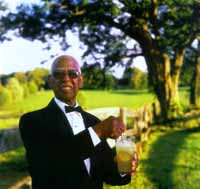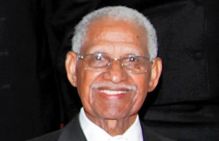George E. Lee Sr., bartender recalled for his secret Southside cocktail recipe, dies
By Jacques Kelly (The Baltimore Sun, 2/1/2016)
Working in a commercial kitchen, George Lee Sr. made and bottled his renowned Southside cocktail mix.
George E. Lee Sr., a retired country club bartender who created his own version of the Southside cocktail mix, died of Jan. 25 of complications from dementia at Envoy Health and Rehabilitation in Pikesville. The Woodlawn resident was 96.
Born in the Cuba Road section of Cockeysville, he was the son of George E. Lee and his wife, Clara. He attended Baltimore County public schools.
“My father was one of 15, and all his brothers and sisters worked for the families who lived in the Green Spring Valley,” said his daughter, Deborah Singletary of Baltimore. “My father began his years of service in their homes and became a butler.”
After working for a Baltimore County family from 1939 to 1943, he became a bartender at the old Ten Mile House on Reisterstown Road between McDonogh and Greenspring Valley roads. He worked there for nearly 25 years.
In a 2000 interview in Baltimore Style magazine, Mr. Lee said he came upon a recipe for the Southside cocktail, which some say traces its name to Chicago’s South Side. Mixology lore suggests that people thought the taste of poor-quality Prohibition gin could be masked by citrus and mint.
Continue reading at The Baltimore Sun.
Baltimore Style Magazine: George Lee
 I watch George Lee behind the bar as he assembles Southside after Southside, pouring in first the Mount Gay rum (or the occasional vodka or gin), then a few ounces of mix, before filling the glass with ice and adding a splash of club soda. Stirred with a beautiful sterling Kirk Stieff iced-tea spoon and topped with a wedge of lime, the drink is a cool shade of green, its glass beginning to bead with condensation as he hands it over.
I watch George Lee behind the bar as he assembles Southside after Southside, pouring in first the Mount Gay rum (or the occasional vodka or gin), then a few ounces of mix, before filling the glass with ice and adding a splash of club soda. Stirred with a beautiful sterling Kirk Stieff iced-tea spoon and topped with a wedge of lime, the drink is a cool shade of green, its glass beginning to bead with condensation as he hands it over.
I’d love to have the recipe.
A magical combination of mint, lemon and sweetener, the Southside mix exudes East Coast country club cachet. At Green Spring Valley Hunt Club, where the Southside has been served since 1929, only the head bartenders have been privy to its contents; the recipe being passed down behind closed doors.
George Lee, who hails from Cockeysville, first came across the Southside recipe in a bar book published by a Long Island club. He got his start in the drink-pouring business in 1939 as a butler for a Baltimore family. Four years later, he began a 25-year tenure at the Ten Mile House, a tavern on Reisterstown Road that would close its doors in 1967.
“I made up a batch for the Ten Mile House,” Lee recalls about his first foray into Southsides. “Folks didn’t go wild for it right away; it caught on slowly.”
Continue reading at Baltimore Style.
Southside: a cocktail that’s for more than the country-club set
By Rob Kasper (The Baltimore Sun, 8/15/2007)
The Southside, a tangy cocktail made with mint, citrus juices and secrets, is an old-line favorite. It appears in the spring at tailgates in the Maryland hunt country and is still stirring at late-summer, white-shoe gatherings.
Once served almost exclusively at private clubs, the cocktail has entered the public domain. Anyone of age now can enjoy a Southside by simply buying a mix and adding ice, rum, gin or vodka, and perhaps some club soda. Membership not required.
Recently, I bought a bottle of Lindsay’s Southside Mix, then compared the beverage it produced with the Southsides of Andy Ervin, the 85-year-old bartender at the Elkridge Club, and George Lee, the 87-year-old former bartender at the Green Spring Valley Hunt Club.
Ervin gave me a recipe that closely resembles the version of the drink he created at the Elkridge Club. Lee provided me with a bottle of a Southside mix that he sells. Both men were gracious, but when I pressed them on specifics, they just smiled. Certain things about the Southside, they said, should remain mysterious.
This country-club cocktail supposedly traces its origin to the bootlegging joints on the South Side of Chicago. During Prohibition, illegal gin made on the city’s South Side was flavored with citrus juices and sugar to cover up the flaws in the hooch. Or so one story, told in 2004 to a National Public Radio reporter by a retired Long Island, N.Y., bartender, goes.
Ervin, born on Baltimore’s east side, said he began making the drink 46 years ago, when he started working at the Elkridge Club. “There were no mixed drinks here, when I came,” Ervin told me. “So I started experimenting.”
Continue reading at The Baltimore Sun.
from Baltimore Or Less http://www.baltimoreorless.com/2016/02/20909/

No comments:
Post a Comment